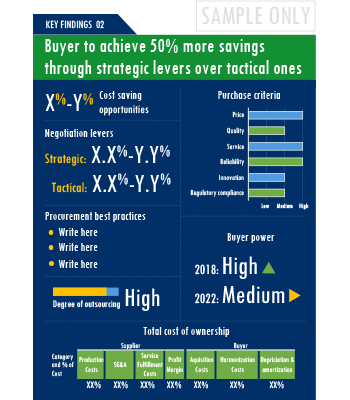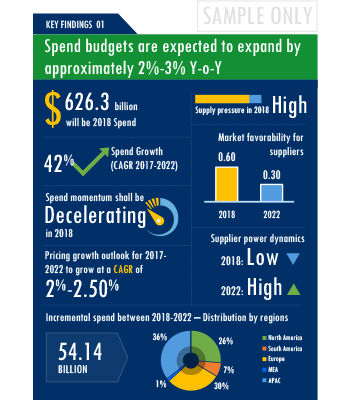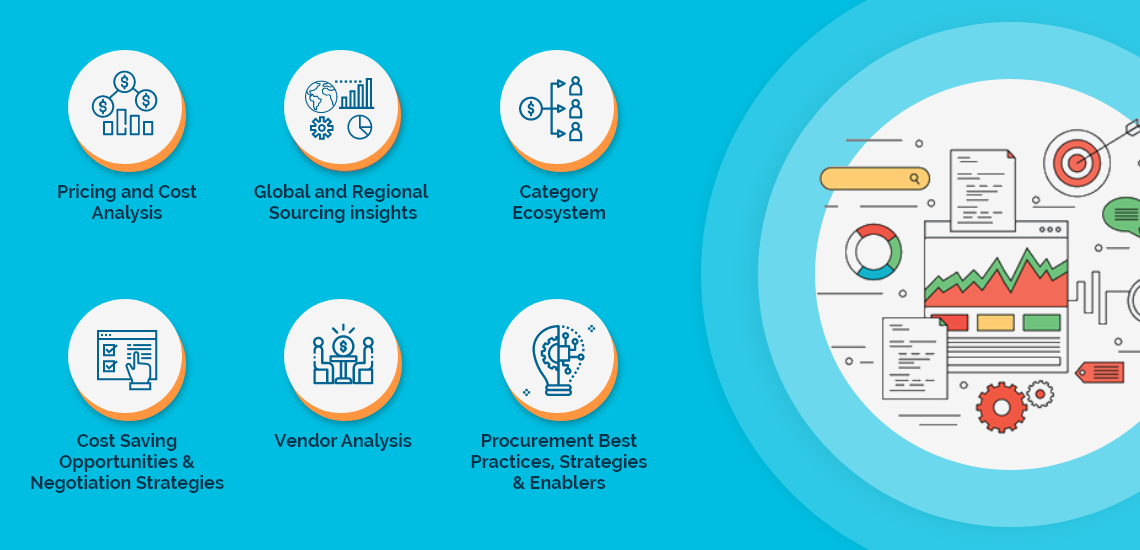A buying guide for Vegetable Oils category – enriched with research on Vegetable Oils procurement spend patterns, Vegetable Oils pricing intelligence, market dynamics and top suppliers of Vegetable Oils.
GET FREE SAMPLEEcosystem of the global Vegetable Oils category is intertwined with the larger parent market of Food and Beverages. Our category definition describes that overall Food and Beverages market includes all spend relating to raw food and beverages required to prepare meals for clients and staff. If the food has been provided as a meal, then it should be excluded from this category.
Several macro changes in the dynamics of overall Food and Beverages as well as Vegetable Oils procurement trends are poised to change the business practices and procurement thumb rules. Buyers of Vegetable Oils are insisting on hard evidence to support cost reduction. Suppliers are responding with elaborate matrix of KPIs that provide managers actionable data on supplier performance and cost savings achieved. The category has historically lagged in tech adoption due to inadequate skillsets of majority of workforce and the perennial requirement to reduce facilities related cost. Therefore, suppliers who have demonstrated technological prowess to achieve efficiencies are being preferred over traditional vendors. Several macro level trends such as slowing economic growth, trade conflicts, rising wages and technological disruptions have put pressure on managers to reduce their spend on Vegetable Oils without affecting the performance. Category managers need to take note of the potential of these developments and reassess the changes required in their procurement practices.
It has become imperative for category managers to remain as agile as possible in terms of their procurement practices. However, it is not always easy to quickly spot and implement alternative practices in a category like Vegetable Oils. To help quick decision making, this report advises on several procurement best practices that have worked well for category managers. For example, Buyers require industry-specific services to effectively operate their production facilities. Thus, they should opt for service providers that can offer customization and bring in years of experience in serving the needs of that industry.Category managers must explore opportunities to integrate planning and management activities of categories using analytics, to gain better control over category spend. This will also allow them to consolidate their supply base easily, as well as to segment suppliers based on requirements and spend on each supplier.Investing in benchmarking studies that help category managers enhance their knowledge on pricing or billing rates of suppliers allows them to not only save costs, but also negotiate better with suppliers. For example, while negotiating for bundled services, they can save significantly on a single service by cross-verifying rates quoted by suppliers against industry benchmarks.
Activate your free account to gain easy access to cutting edge research and insights on consumers, emerging price trends, global and regional suppliers.
Vegetable Oils procurement managers also need to proactively identify and mitigate potential risks that can arise in the supply chain or contracts for Vegetable Oils procurement. Some examples include:
For detailed insights and complete access to our report library, activate your free account!
The report is intended to serve as a one-stop reference guide for Vegetable Oils procurement strategy and offers a perfect blend of category basics with deep-dive category data and insights. Therefore, it is ideal for category beginners looking for “Vegetable Oils: Procurement Report 101” as well as for category experts actively tracking the global Vegetable Oils procurement market.
You may have just initiated your research to design a winning Vegetable Oils procurement strategy, or you may be a category expert looking for strategic insights and updated data.Either ways, the report has your requirements covered.

Unlock SpendEdge's comprehensive procurement report collection with ease through our procurement platform.
Procurement decisions can prove to be costly in the absence of careful deliberation and evaluation of every available option. In fact, more than 90% of the decision makers we work with acknowledge that timely availability of up-to-date category intelligence can help them make better purchasing decisions. More than 80% of them believe that in-house category intelligence needs to be updated periodically to achieve full benefits. If you have read so far, we are quite sure you agree!!
The Vegetable Oils procurement report helps take more informed decisions by placing all the critical information and advice at the fingertips of a decision maker. It also specifically answers some of the key questions that we have been routinely asked during our industry outreach initiatives:
SpendEdge Insights has helped procurement professionals and sourcing teams manage multiple spend areas and achieve more than $2 billion in savings. Activate your free account today!
The Vegetable Oils market report offers a complete picture of the supply market and analyzes the category from the perspective of both buyers and suppliers. Analysis of the category trends, procurement best practices, negotiation levers and overall category management strategy advisory are interspersed with in-depth data and commentary on spend outlook, pricing ecosystem and supplier landscape drilled down to a region-level coverage.

A key highlight of this report is the in-depth outlook created on Vegetable Oils procurement spend and pricing trends. The report further delves deep into the aspects of cost structure, total cost of ownership and supplier margins for Vegetable Oils. A dedicated section to supplier profiles and evaluation helps decision makers cast a wider procurement net and identify gaps in existing relationships.

Along with specific category and supplier intelligence, the publication also includes curated insights on Vegetable Oils market trends, price influencers and inherent risks. These insights help the decision makers prepare for market shaping trends in advance and create alternative strategies for changes in the market conditions.

Additionally, the report also advises on the best practices and strategies to manage the Vegetable Oils category efficiently. Negotiation levers and opportunities are explained in detail along with quantification of their potential. Benchmark KPIs for supplier and buyer performance management are also aggregated to better organize the category objectives. Other themes of advisory include ideal procurement organization structure, enablers to achieve KPIs or category objectives and ideal SLAs to have with suppliers.






Our research is complex, but our reports are easy to digest. Quantitative analysis and exhaustive commentary is placed in an easy to read format that gives you an in-depth knowledge on the category without spending hours to figure out “what does it mean for my company?”


SpendEdge presents a detailed picture of Vegetable Oils procurement solutions by way of study, synthesis, and summation of data from multiple sources. The analysts have presented the various facets of the market with a particular focus on identifying the key category influencers. The data thus presented is comprehensive, reliable, and the result of extensive research, both primary and secondary.

Global Hydrogenated Oils Market - Procurement Intelligence Report

Global Garlic Market - Procurement Intelligence Report

Global Tallow Market - Procurement Intelligence Report

Global Organic Food Market - Procurement Intelligence Report

Global Salt Market - Procurement Intelligence Report

Global Oilcake Market - Procurement Intelligence Report

Global Syrups Market - Procurement Intelligence Report

Global Margarine Market - Procurement Intelligence Report

Global Dextrin Market - Procurement Intelligence Report
Access this report and our entire procurement platform | Plans starting from USD 3000/ Year Buy Now
Copyright © 2025 Infiniti Research Limited. All Rights Reserved. Privacy Notice – Terms of Use – Sales and Subscription
Cookie Policy
The Site uses cookies to record users' preferences in relation to the functionality of accessibility. We, our Affiliates, and our Vendors may store and access cookies on a device, and process personal data including unique identifiers sent by a device, to personalise content, tailor, and report on advertising and to analyse our traffic. By clicking “I’m fine with this”, you are allowing the use of these cookies. You may change your settings based on a legitimate interest at any time, by selecting “Manage Settings” on our site. Please refer to the help guide of your browser for further information on cookies, including how to disable them. Review our Privacy & Cookie Notice.
